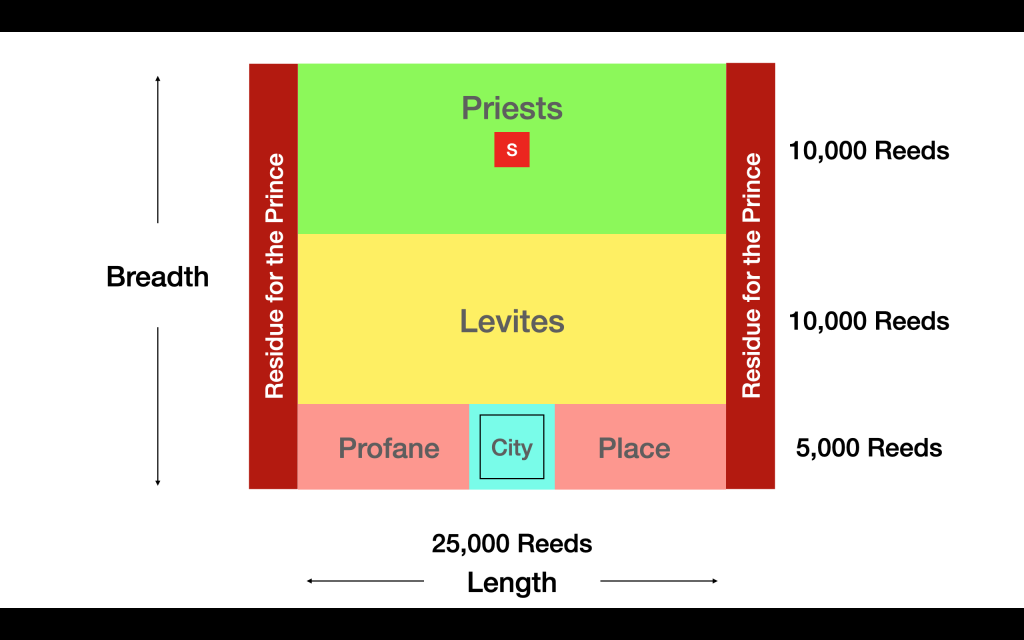Ezek 45:1-8 lists the dimensions and location of the holy portion for the priests and the sanctuary, the Levites, the profane place for the city, and the prince’s portion.
The Holy Portion
Priests and sanctuary, v.1-4; Ezek 48:9-12. 25,000 reeds long by 10,000 broad. This is their holy portion. The sanctuary is in the middle of their portion (in red and labeled “S” in the image below).
Levites, v.5; Ezek 48:13-14. 25,000 reeds long by 10,000 broad. This is their holy portion.
City, v.6; Ezek 48:15-17 5,000 reeds square. 25,000 reeds long by 5,000 broad; v.18-19, the residue of 10,000 eastward and 10,000 westward is for food for them that serve the city (called the profane place).
Prince, v.7-8; Ezek 48:21-22. The residue on either side of the holy portions and the profane place (east and west) are for the prince and his sons.
Below is an image of the oblations.

The Standards – Ezek 45:9-12
The standard of justice, v.9. Princes are to remove violence and spoil, like getting thieves and criminals off the street, for instance. They are to execute judgment, impartial and just sentencing, and justice, impartiality in distributing to every man that right or equity which the laws require. And they are to cease using their power to unjustly demand illegal payments of fees and tributes.
The standard of weights and measures, v. 10-11. Just balances are required, so that whenever goods are weighed, whether buying or selling, the standard of measure on the other side of the scale is always the same.
Just ephah and bath. The ephah is the dry measure and the bath is the liquid measure. The ephah and the bath are the same, just like a cup of sugar and a cup of honey can be measured in the same device. The ephah and bath are both 1/10th of a homer. In liquid measures, the homer is also called the cor, v.14.
The standard of money, v.12. The shekel is twenty gerahs, Ex 30:13, for example. And then Ezekiel wrote, “twenty shekels, five and twenty shekels, fifteen shekels shall be your maneh”. Maneh is translated “pound” in 1 Ki 10:17, Ezra 2:69, Neh 7:71. In Solomon’s day, a pound was equivalent to one hundred shekels. Compare 1 Ki 10:17 with 2 Chr 9:16 where 3 pound of gold equals 300 shekels of gold.
These three measures must be the fractional denominations of one maneh, for making payments. Anything under 15 is paid in shekels. Then everything from 15 and up can be paid in increments of 5 with these “coins” and combinations of these coins. For example:
15 = 1×15; 20 = 1×20; 25 = 1×25; 30 = 2×15; 35 = 15+20; 40 = 2×20; 45 = 20+25; 50 = 2×25; 55 = 2×20+15; 60 = 15+20+25 or 3×20; etc.
The Prince’s Oblation and Offerings
See Ezek 45:13-17. The oblation is 1/6 ephah of wheat and 1/6 ephah of barley with 1/10 bath of oil and 1 lamb out of two hundred. These are for a meat offering, and for a burnt offering and for peace offerings to make reconciliation for them. The people give this oblation for the prince, v.13-16.
The prince’s part is to give burnt offerings, meat offerings, and drink offerings, in the feasts, the new moons, and the sabbaths, in all solemnities. He prepares the sin offering, meat offering, burnt offering, and peace offerings to make reconciliation for the house of Israel. Thus, Col 2:16-17 is true, and these Old Testament ordinances were a shadow of things to come.
During the millennium, offerings are made to make reconciliation for the house, v.17; for God’s pleasure, Ps 51:17-19; for remembrance or a memorial, Heb 10:3; and to feed the priests, Ezek 44:27-31. They are not to replace the offering of Jesus Christ on Calvary.
To study the prior lesson, see Temple Ordinances. To study the next lesson, see Prince’s and Peoples Ordinances.
